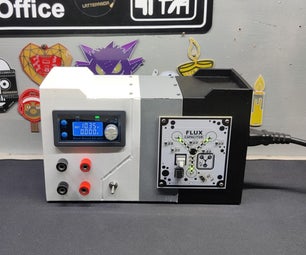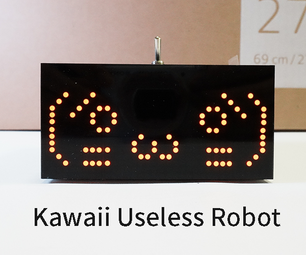Introduction: How to Make Simple "motion" Sensors
Well, sometimes we need to switch something by position change or movement... It is easier than you thought!!!! I am going to cover 2 kinds of "motion" sensors in this instructable.
The first one is a ball-based vibration detector. It detects any kind of movement. It's only disadvantage is that the contact time is really short at this sensor, so you have to connect it to a very sensitive circuit or prolong the signal length by a programmed PIC, somehow like Xyzzy did in his DIY RumblePak for Nintendo DS.
The second one is a tilt sensor (well, it is ball-based, too). This is the sensor used in my other project, home-made Guitar Hero controller. It is very simple and still quite effective!!!
The first one is a ball-based vibration detector. It detects any kind of movement. It's only disadvantage is that the contact time is really short at this sensor, so you have to connect it to a very sensitive circuit or prolong the signal length by a programmed PIC, somehow like Xyzzy did in his DIY RumblePak for Nintendo DS.
The second one is a tilt sensor (well, it is ball-based, too). This is the sensor used in my other project, home-made Guitar Hero controller. It is very simple and still quite effective!!!
Step 1: First Type - Components Needed
So you gonna' need the following components:
- a piece of thicker and harder copper wire
- a spring (e.g. from a pen)
- an iron ball (e.g. from a ball bearing system) - of course proportional to the other components
- soldering-iron and some solder
- and of course a bit of hot glue
So here it is how it worx:
The spring starts to move (or rather vibrate) because of the mass of the ball (you know, the friggin' inertial force _). If the movement is big enough, the ball makes contact with the copper wire (both physically and electrically).
- a piece of thicker and harder copper wire
- a spring (e.g. from a pen)
- an iron ball (e.g. from a ball bearing system) - of course proportional to the other components
- soldering-iron and some solder
- and of course a bit of hot glue
So here it is how it worx:
The spring starts to move (or rather vibrate) because of the mass of the ball (you know, the friggin' inertial force _). If the movement is big enough, the ball makes contact with the copper wire (both physically and electrically).
Step 2: First Type - Construction
You need to solder the ball and the spring together like you can see it on the picture. Then solder a piece of the hard copper wire (from the mentioned one) to the other side of the spring. Next you need to make a circle at the end of the remaining wire - the bigger the circle the less sensitive will the sensor be (but maintain the proportions - or position the spring correctly). You can also set the sensitivity of the sensor by shortening the spring (or by stabilizing the root of the spring - e.g. by soldering). I know it is a little bit hard to tune it properly for your needs, but it is possible.
Step 3: First Type - Done!!
Now you need to solder 2 wires to the 2 separate parts of the sensor. After that glue them together as seen on the picture. Warning! Don't let the two wires make contact nowhere - the only place where it can make contact is the upper part - the ball and the copper circle!
And voila, it's done! Enjoy! For the next one go to the next step!
And voila, it's done! Enjoy! For the next one go to the next step!
Step 4: Second Type - Components Needed
You need the following components:
- 2 pieces of thick copper wire
- copper tube (our tube was chromed - harder to solder)
- an iron ball (e.g. from a ball bearing system) - of course it must fit to the tube
- soldering-iron and some solder
- a bit of hot glue
How it worx?
As you change the position of the sensor (a few degrees from horizontal) the ball rolls to one side of the tube (that damned gravity... _) and if it's the side where the central contact is (made from the wire), the ball makes electrical contact between the tube and the wire - and that's it!
- 2 pieces of thick copper wire
- copper tube (our tube was chromed - harder to solder)
- an iron ball (e.g. from a ball bearing system) - of course it must fit to the tube
- soldering-iron and some solder
- a bit of hot glue
How it worx?
As you change the position of the sensor (a few degrees from horizontal) the ball rolls to one side of the tube (that damned gravity... _) and if it's the side where the central contact is (made from the wire), the ball makes electrical contact between the tube and the wire - and that's it!
Step 5: Second Type - Construction
Place the ball to the tube and make sure it won't fall out from on side of it (glue, solder or plug there something - or hit it with a smaller hammer). My tube was cut in a way that it wasn't an issue. Remove the insulation from the ends of the 1st wire then make small circle on one end. Then make a shape from the whole wire according to the shape of the tube (as seen on the 2nd pic). It will hold itself in place. Place it on the tube (like on the 3rd pic) - you know, the small circle must be on the side which is not plugged... Make sure there is no el. contact between the copper wire and the tube. Glue it the wire to the tube as it is now.
Step 6: Second Type - Done!!
Wrap the second copper wire around the tube (see the pic). To make a better el. contact, solder it to the tube. If yours is chromed too, scratch the soldering place of the tube a little bit with a Stanley knife and try to solder it after that. In the end, hot-glue it a bit and it's done! Enjoy! it works very well as the sensor of the Guitar Hero controller.









